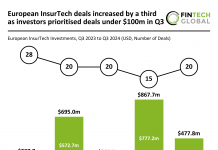From insider trading and market manipulation to bribery, corruption as well as money laundering, detecting suspicious activity has become a top priority for financial firms, making it imperative to have a robust compliance surveillance solution in place, according to Relativity Trace general manager Jordan Domash.
For financial institutions and organisations that are highly regulated, the current regulatory environment places a heavy burden to detect and take action on non-compliant behaviour. And, delaying action on suspicious activity—risking an investigation, regulatory inquiry or litigation—is not something they can risk.
When Domash noticed an escalated demand for proactive compliance monitoring, he saw an opportunity to design a platform to help compliance leaders in some of the most highly regulated organisations. “Relativity’s software has been applying machine learning for 20 years, sifting through hundreds of millions of files to find the 1000 that are going to be your evidence in a litigation or that you’re going to have to produce to a regulator,” he said. That’s when he realised that the gap in the surveillance market was the lack of AI used for real-time monitoring and launched Relativity Trace, an AI-powered communication surveillance platform from Relativity.
Relativity was originally designed as a platform for e-discovery and investigations. Relativity Trace is a compliance monitoring application built on the Relativity platform that leverages AI technology, advanced analytics and visualisations to enable teams to ingest all forms of communication including email, chat and audio files in near-real-time and flag the highest-risk content for further review.
With watchdogs such as the Banking Royal Commission in Australia, MiFID II and MAR in the EU and the Senior Managers Regime in the UK, the obligation to detect abuse and adhere to efficient compliance processes along with the risks to brand reputation and regulatory injunction is only growing.
Indeed, in the event of compliance failures, there is a massive risk of legal, reputational and financial damage. In the past, banks have been fined billions of dollars for compliance and regulatory errors. Bribery and corruption have seen political leaders and corporate executives go down proving that the stakes of non-compliance have never been higher. As a result, it’s easy to see how the global trade surveillance market size is expected to reach $2.9bn by 2027, registering a CAGR of 19.7% over the forecast period, according to a report by Grand View Research.
Roadblocks in compliance surveillance
The times are a-changing. Businesses today are expected to be active all the time, everywhere and in multiple languages. Financial services executives face constant pressure to identify and mitigate a growing list of regulatory and policy-driven risks. The volume, variety and velocity of data and alerts created and used by organisations are exploding giving rise to the false positive conundrum.
To add on, as more companies were forced to move to remote working after the COVID-19-induced lockdown, the arrival of new communication channels such as social media, chat apps, audio recordings, SMS and email have created new means for sharing information and potentially violating rules and regulations. According to Domash, this places additional demands on a firm’s ability to monitor and enforce compliance as employees have to wade through oceans of data in silos.
Most of the surveillance market today uses lexicons or basic words and phrases to generate alerts. “While most lexicon alerts are based on keywords that technically could be used in a context of misconduct, many times it might just be in a normal conversation resulting in tonnes of poor quality alerts being generated,” Domash added. This makes it a herculean task for teams to sift through all of those alerts. “This often turns review teams into an alert factory where on getting an alert, they need to review it. Compliance teams don’t have the time to really put on their investigator hat and understand the context behind an alert, do investigatory workflows and actually uncover misconduct as they are overwhelmed by the number of alerts,” he said. Consequently, they fall short of the time for forensic review to avoid violations that could lead to greater regulatory scrutiny.
Surveillance in an AI-driven world and Relativity Trace’s role
Tellingly, the monitoring process has become too complex to rely on individuals to recognise a problem. Businesses need tech tools that can rapidly assess vast information sets across multiple systems to identify—and possibly take action to avoid—corruption, data loss or breaches. Highlighting the importance of using technology, Domash said that the key to reducing high false positive rates involves using techniques from machine learning and AI. “One of the biggest impacts of AI is that it removes all the junk, duplicative and irrelevant content. The efficiency that AI can provide compliance teams is more important than ever as data and communications increase,” he added.
Furthermore, given that AI has the ability to spot patterns across large volumes of data and learn from prior reviews over time, it is able to understand the difference between a risk and a false positive as well as provide context for complicated alerts. “For instance, if an alert is generated and you don’t understand it, instead of escalating it and running manual searches, the AI will simply say, ‘read this email, it’s going to help you understand the context of this paragraph.’ This can make your team’s or clients’ teams a lot more efficient,” Domash detailed.
He added that while most fear AI will take away people’s jobs, it is created to assist humans so they can prioritise the more important tasks. “AI is meant to supplement the compliance assessing team so that the human reviewer can focus on making the final decision on what’s risky and escalating only the true compliance violations,” Domash said.
However, finding the balance between comprehensive monitoring that surfaces all possible incidents and minimising time-consuming false positives covering a host of communication channels is tricky. Domash added that every data source requires a different AI process and companies must ensure that “they have a system that recognises the differences between each of the different data sources.”
What sets Relativity Trace apart is that it automatically ingests email, audio and chat data alongside attachments of over 900 different file types. Its deep language capabilities can identify and translate over 100 languages. It connects to all the big financial and enterprise systems including Bloomberg, Reuters, Skype and Slack as well as collaboration apps like Microsoft Exchange, Teams, Office 365, OneDrive and Box among others. “Our machine learning models detect risk, spam, language identification among a host of other threats to reduce false positives,” Domash said.
One of Relativity Trace’s key features is that it leverages a suite of AI technologies by embedding it in every aspect of its application which can be configured end-to-end to specific workflows. Detailing some of the traditional compliance surveillance methods used, Domash said that “in a lot of legacy systems, you can’t change or edit them based on your specific needs, you have to adapt your entire workflow to the system itself. But our system is built on the principle that each of our customers are unique and they will want to change things over time. The system should be able to adapt to an organization’s needs and not the other way around, which includes using specific AI models that are relevant to your business.”
Simply put, compliance teams can set custom rules, enabling them to define their own criteria for what constitutes a potential compliance violation. Relativity Trace isn’t just for financial services either. Companies across regulated industries – like pharmaceuticals – can leverage the tool to protect themselves from unethical behaviour and misconduct.
Upcoming trends in compliance surveillance
Looking ahead, there’s no doubt that AI is in fact here to stay, Domash opined. “However, it’s more of an adoption problem than a technology problem. With AI tech, the adoption of these technologies is behind the actual efficacy of it,” he said, adding that the reason behind that is the industry has been rather conservative in embracing modern technologies.
Apart from AI, cloud-based services will become more mainstream. Domash believes that as the amount of data continues to rise, the sector will witness more firms shifting towards cloud compliance surveillance. “The largest banks’ surveillance infrastructure is one of the biggest infrastructures in the entire bank. With data coming in through many sources, it’s a lot to manage and it’s super complex. It’s an industry that makes a lot of sense to be in the cloud,” he continued.
Another trend in the surveillance industry is that the definition of surveillance is likely to expand as platforms will grow their services. “It used to be monitoring emails, chats and audio. Now, we’re actually seeing it expand beyond traditional communication monitoring,” Domash said. “Things like trade reconstruction—taking a trade, mapping it to the communications that are related to control room surveillance—and ingesting restricted and insider lists will, too, become a part of traditional surveillance platforms.”
With AI technology managing the initial screening and reducing the false positives, the role of human reviewers is set to change, Domash said. “Being able to do ad hoc searching, building a case with a case management tool, going beyond the alert that was generated yesterday and finding the context behind it, are skills which are going to be more important over time,” he added. “Again, because they’ll have more time as they won’t have to be churning through the high volume of alerts.”
In conclusion, having an investigatory skillset will become imperative for compliance surveillance executives. “Our vision for the future is that compliance teams become more investigatory, spending more time reviewing each alert and that’s what we can expect 10 years from now,” Domash said.











